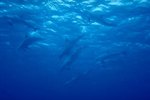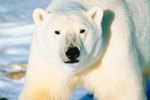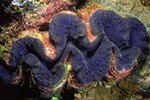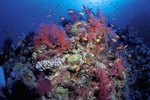
Filter feeders are important components of virtually all aquatic ecosystems. Clams, krill and coral are filter feeders who keep the oceans clean by removing toxins and pollutants from the water column as they feed. But they're not the only ones. Larger animals like ducks, whales and sharks filter-feed to consume large quantities of tiny organisms, like plankton, which helps to keep the greater ecosystem in balance.
How Does Filter Feeding Work?
Filter feeding works just like a pool or aquarium filter does; an animal's mouth collects a volume of particle-laden water, the creature then generates pressure in his body cavity to force the water out through a sieve -- usually modified gills or toothlike structures. Alternatively, locomotion may force the water through gills passively, as in manta rays (Manta birostris) and basking sharks (Cetorhinus maximus). The type and anatomy of the sieve mechanism vary from species to species, but the underlying principle is the same in animals as divergent as tadpoles and flamingos (Phoenicopterus sp.).
Dabbling Ducks
Some ducks, swans and geese are very efficient filter feeders. Ducks and other waterfowl who depend on filter feeding use tiny structures called lamellae to strain food from water. These lamellae are located inside the edges of the bill in several rows. The number of lamellae present speaks to the degree to which a species relies on filter feeding. While most typical dabbling ducks have 50 to 70 lamellae per mandible; the northern shoveler (Anas clypeata), a very successful filter feeder, has nearly 400 lamellae in its mouth. Conversely, ducks like mergansers (Mergus sp.) who feed largely on fish and other macroscopic prey, lack lamellae entirely.
Humpback Whales
Humpback whales (Megaptera novaeangliae) are large filter feeders that prey on zooplankton, krill, and larger fish like sandlance (Ammodytes americanus). Humpback whales gulp a quantity of water, then use their large baleen plates to capture any organisms as the water is forced out of the mouth. Baleen plates are made of keratin -- the same substance that mammalian hair and fingernails are composed of -- that has been highly calcified and is arranged in the whale’s mouth. In humpback whales, the baleen plates resemble coarse-bristle brushes, though baleen appearance can vary in whale species. Humpback whales use a number of feeding techniques to herd their prey; a behavior called bubbling occurs when whales swim under a school of small fish and blow bubbles while swimming in a circle. The air bubbles and turbulence cause the prey to coalesce into a tight ball. Once the prey pack together tightly, the humpback whales swim up with their mouths open to capture large mouthfuls of water and food.
Whale Sharks
Another example of a very large animal that feeds on very small food is the whale shark (Rhincodon typus). The largest fish in the world, the whale shark attains up to 65 feet in length and more than 34 tons in weight. These large sharks travel the oceans, gulping down incredible quantities of water and any animals living in that volume of water. Whale sharks force the water through the large gill slits. These gill slits work like screens, retaining any krill, zooplankton or other small organisms. A 2010 study by Philip J. Motta and colleagues, published in the journal “Zoology," found that a 20-foot-long whale shark filtered about 6 pounds of small crustaceans from the water per hour, enough to provide the fish with 6,500 calories per day.
References
- Museum of the Earth: Filter Feeding
- Animal Diversity Web: Rhincodon Typus
- Animal Diversity Web: Megaptera novaeangliae
- Ducks Unlimited: Waterfowl Feeding Adaptations
- Zoology: Feeding Anatomy, Filter-Feeding Rate, and Diet of Whale Wharks Rhincodon Typus During Surface Ram Filter Feeding off the Yucatan Peninsula, Mexico
- Proceedings of the Royal Society: Biological Sciences: Calcification Provides Mechanical Reinforcement to Whale Baleen Alpha-Keratin
Photo Credits
-
Comstock/Comstock/Getty Images




